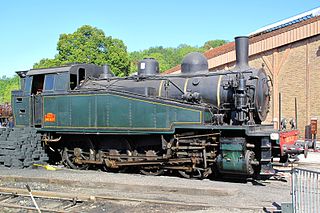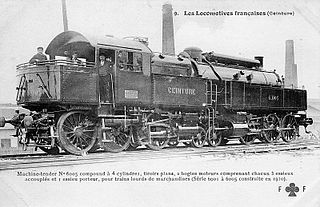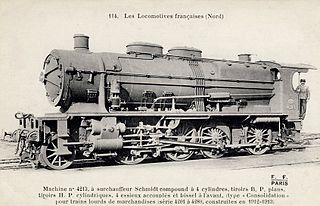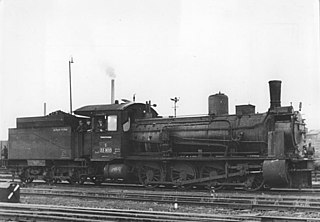Design
In 1923, during the tenure of Louis Breville (1918–1928), Marc de Caso designed the four cylinder compound pacific locomotive, with superheating, and a narrow firebox 3 m long. capable of output of 2,700 hp (2,000 kW). The appearance was due to Gaston Schaeffer who grouped all the outside pipes together and ran them along the boiler. Their boilers were superb, which is the reason why André Chapelon later based some of his locomotive boilers on this design.
The locomotives were not equipped with mechanical stokers which made the job of the fireman harder as he had to throw the coal uniformly throughout the firebox. The cab was not enclosed, a characteristic found throughout the Chemins de Fer du Nord, and drivers gave it the nickname rendez-vous des courants d'air. The Nord specification tender was built to such a quality that the SNCF used the same design for its own tender locomotives twenty years later.

État 40-001 to 40-143 was a class of 0-8-0 Tank locomotives of the Chemins de Fer de l'État. They later served with the SNCF who renumbered them 3-040.TA.1 to 3-040.TA.143.

État 141-001 to 141-250, was a series of 2-8-2 steam locomotives of the Chemins de Fer de l'État.

État 231-500 to 231-783 was a series of 4-6-2 steam locomotives of the Chemin de fer de l'État.

État 231-011 to 231-060 was a small class of 4-6-2 steam locomotive of the Chemin de fer de l'État.

État 230-781 to 230-800 was a small class of 4-6-0 steam locomotives of the Chemin de fer de l'État.

The SNCF 4-240A class and SNCF 5-240P class was a group of 37 4-8-0 steam locomotives designed by André Chapelon, and regarded by some, as one of his best designs.

The du Bousquet locomotive was an unusual design of articulated steam locomotive invented by French locomotive designer Gaston du Bousquet. The design was a tank locomotive, carrying all its fuel and water on board the locomotive proper, and a compound locomotive. The boiler and superstructure were supported upon two swivelling trucks, in a manner similar to a Meyer locomotive.

The Prussian Class P 8 of the Prussian state railways was a 4-6-0 steam locomotive built from 1906 to 1923 by the Berliner Maschinenbau and twelve other German factories. The design was created by Robert Garbe. It was intended as a successor to the Prussian P 6, which was regarded as unsatisfactory.

Nord 4.1201 to 4.1272 was a class of French Mikado tank locomotives built for suburban service on the Chemin de fer du Nord's lines that are north of Paris.
Nord 5.1201 to 5.1230 were a class of 2-10-0 “Decapod” steam locomotives of the Chemins de Fer du Nord, designed to handle heavy coal trains. On 1 January 1938, they all passed to the SNCF, who numbered them 2-150.B.1 to 30.

Nord 4.061 to 4.340 were a class of 2-8-0 tender goods locomotives of the Chemins de fer du Nord. At nationalisation on 1 January 1938 they all passed to the SNCF who renumbered them 2-140.A.1 to 2-140.A.280.

Nord 2.231 à 2.305 were suburban 4-4-4T locomotives of the Chemins de Fer du Nord. They were nicknamed "Revolver" due to the appearance of the high-pitched small diameter boilers next to the low water tanks and cabs,

SNCF 232.P.1 was an experimental prototype high-pressure steam locomotive ordered by the Chemins de fer du Nord, but delivered to the Société nationale des chemins de fer français (SNCF) in 1939. It was the first and only member of SNCF's first class of 4-6-4 or Hudson type of locomotives.

SNCF 150.P were a class of 2-10-0 “Decapod” steam locomotives built as standard locomotives of the newly created Société Nationale des Chemins de fer Français (SNCF) between April 1940 and April 1950

Nord 3.1101 and 3.1102 were a class of two express passenger 4-6-4 (Baltic) tender locomotives designed by Gaston du Bousquet for the Chemins de Fer du Nord, and built in the company's La Chapelle Workshops.

Ceinture 51 to 65 were a class of fifteen 4-6-0T locomotives built in 1902 for the Syndicat d'Exploitation des Chemins de fer de Ceinture de Paris. They passed to the Chemins de fer du Nord in 1934 who renumbered them Nord 3.701 to 3.715. In 1938 they passed to the SNCF who renumbered them 230.TA.1 to 230.TA.6.

Ceinture 21 to 35 were a class of fifteen French 0-6-0T locomotives of the Syndicat d'Exploitation des Chemins de fer de Ceinture de Paris. built in 1899 for pulling suburban passenger trains.
Nord 360 to 399, renumbered to Nord 4.361 to 4.400 in 1872, were 0-8-4T Engerth locomotives for freight traffic of the Chemins de Fer du Nord. The machines were built in 1856–1857 and retired from service in 1907–1910.

The Prussian G 7.2 was a class of 0-8-0 tender compound locomotives of the Prussian state railways. In the 1925 renumbering plan of Deutsche Reichsbahn, the former Prussian locomotives produced from 1895 to 1911 were given the class designation 55.7–13; while the locomotives of former Mecklenburgische Friedrich-Franz-Eisenbahn (MFFE) locomotives were classified as 55.57.
This page is based on this
Wikipedia article Text is available under the
CC BY-SA 4.0 license; additional terms may apply.
Images, videos and audio are available under their respective licenses.

















